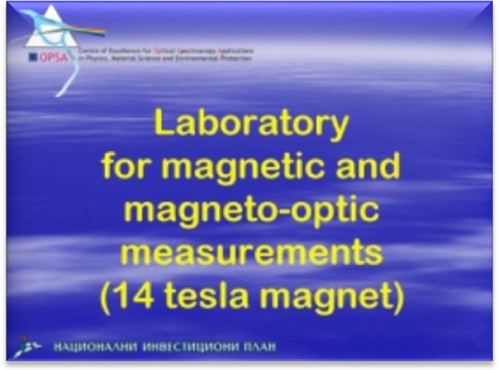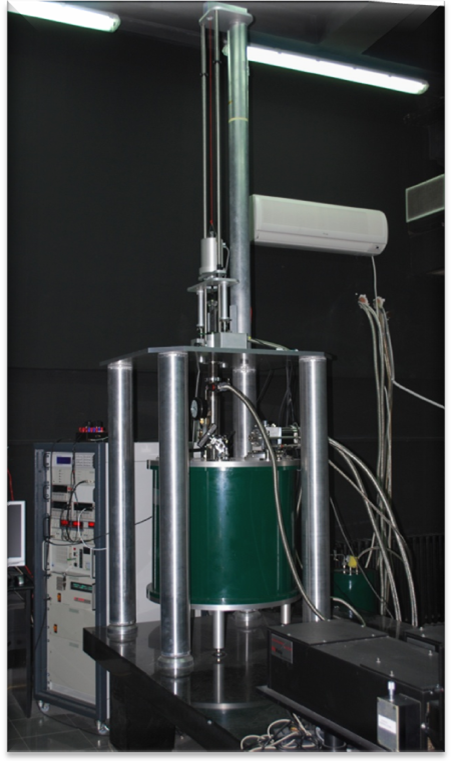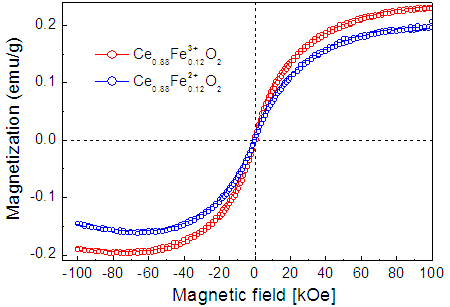
Laboratory for magnetic and magneto-optic measurements is equipped with a 14 T cryogen free measurement system (Cryogenic Ltd. superconducting magnet with a vibrating sample magnetometer, a resistivity and Hall effect set-up, a specific heat system). This system has an optical window at the bottom of the cryostat for optical connection with the TriVista TR557 triple Raman system so that Raman and photoluminescence measurements can be performed at low temperatures and in high magnetic fields.
High Magnetic Field Measurement System
The High Magnetic Field Measurement System (HMFMS) made by Cryogenic is a very versatile system for various experiments and measurements in high magnetic fields up to 14 T, within the temperature range from 1.6 K to 325 K. The HMFMS is capable of measuring several physical quantities:
-
Magnetic moment and magnetization using a Vibrating Sample Magnetometer (VSM)
-
AC Susceptibility
-
Electrical resistivity
-
Hall Effect constant
-
Specific Heat
 |
| 14 tesla cryogenic free measuring system |
The HMFMS is a “cryogen free system”, meaning it does not use liquid helium for cooling superconducting magnets. Instead, it uses a closed cycle system of helium gas cooling with a compresor. The main advantage of a cryogen free system is the low operating cost. No liquid helium or nitrogen is required for cooling down or operation; there are no costs associated with storage and transport of liquids. Safety issues and training for personnel are minimised. It is also simple to use: switch on the cooler and wait for it to reach the operating temperature; the system is then ready to use.
In the core of the system is a superconducting magnet, based on a NbTi/Nb3Sn alloy. The magnet is able to achive magnetic fields of up to 14 T, with a magnet energation rate up to 0.7 T/min, and with a central field homogeneity of 0.001% over 25mm. The sample is mounted on a probe which is placed inside the Variable Temperature Insert (VTI) which allows for sample temperature variation in the 1.6-325K range. The temperature stability is ± 0.05 K, and a typical cooldown time for the entire system is about 28 hours.
By changing a probe holder it can be easily changed the type of measurement performed on the system, i.e. the system can be used in different configurations for different experiments. The system is using a LabView based software for monitoring and data collection which enables automated multisequence measurements.
Vibrating sample magnetometer
The Cryogenic VSM is a research instrument for measurements of the DC magnetic moment in the fields of up to 14 Tesla. In order to generate a signal proportional to the magnetic moment, the sample is set to vibrate in a constant (or slowly varying) applied field. The signal is detected by an astatic pair of pick-up coils. The coils sense the variation of magnetic flux due to the sample movement. The typical frequency of vibration is around 20 Hz, and the amplitude is 1 mm. The pick-up coils are located inside the VTI within the bore of the superconducting magnet. The signal is detected by a lock-in amplifier.
Specification
Vibration frequency:
1 – 100 Hz, typically 21 Hz
Maximum sample size:
10 mm
Optimum sample size:
5mm or smaller
Noise base (10 s averaging)
: 10-6 emu
Dynamic range (standard): 108
Accuracy and
reproducibility:
0.5%
|
|
|
|
|
AC susceptometer The AC magnetic susceptibility of a sample is measured by applying a small AC field using a drive (or primary) field coil and detecting the sample response with an astatic pair of pick-up (or secondary) coils. In the absence of the sample the coils are balanced so that the output signal is zero. When the sample is positioned inside one of the pick-up coils, the balance is disturbed, and the resulting output signal is proportional to the sample susceptibility. Generally, there is a phase shift between the AC field and the sample response. Therefore the dynamic susceptibility is usually represented in terms of the real and imaginary parts. The real part is the characteristic of reversible processes, and the imaginary part characterises the energy dissipation. |
|
Specification:
Maximum AC
field amplitude: 20 gauss at 100 Hz |
|
Specific heat measurements The Cryogenic Ltd. miniature AC calorimeter is designed to measure the heat capacity of samples weighing as little as one microgram. The AC calorimeter is based on an AC technique that offers unsurpassed sensitivity combined with simplicity of operation. The sample is mounted onto the calorimeter membrane using thermally conductive vacuum grease mounted in a closed cell with low-pressure exchange gas. The complete probe is loaded through an airlock into the VTI. |
|
Specification:
Temperature
range: 5 – 300 K |
Electrical resistivity and Hall
effect measurements
The Resistivity system is configured for 4-terminal resistance
measurements and Hall voltage measurements in the range from μΩ to MΩ
resistance. The resistance is measured by a high quality digital
voltmeter and a current source. The standard sample platform is
typically 15 mm x 50 mm with 8 electrical connections for two samples.
|
|
| Probe for Electrical resistivity and Hall-effect measurements |
|
Specification:
DC resistance measurement range:
10-7 to 10-8 Ω |
Center
for Solid State and New Materials :: Facilities
:: Laboratory for
::
print
